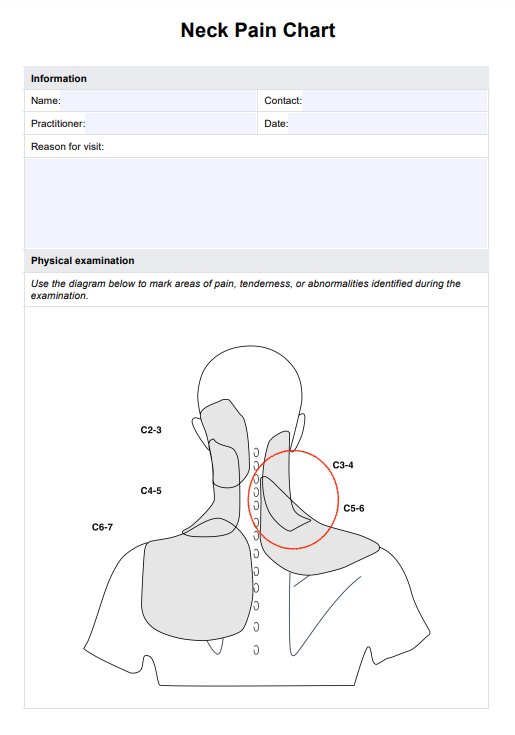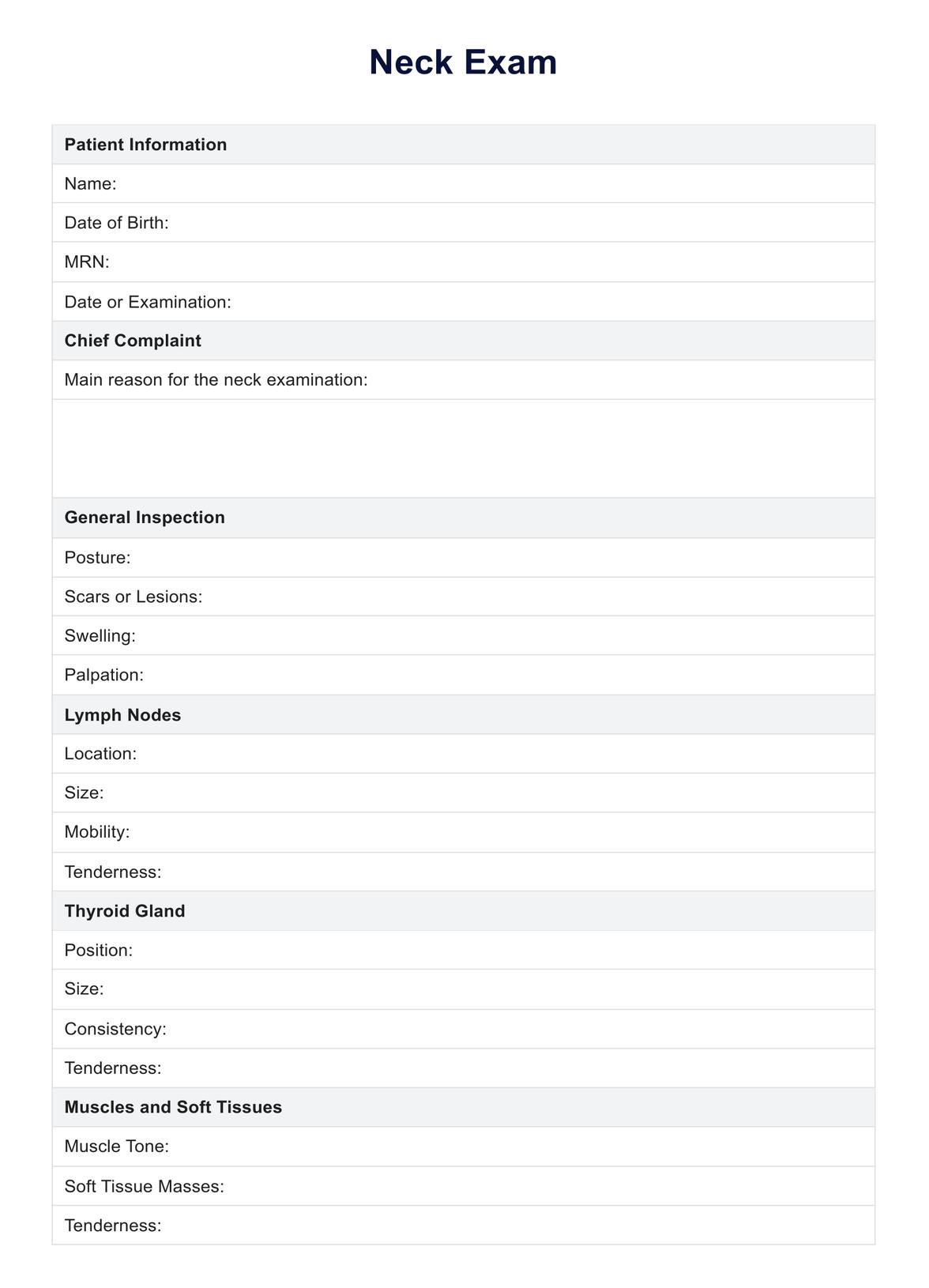Neck Pain Chart
Access our Neck Pain Chart, a professional tool for assessing and documenting neck pain, aiding in diagnosis, treatment planning, and improving patient care.


What is a Neck Pain Chart?
A Neck Pain Chart is a structured tool designed to help healthcare professionals assess, document, and manage neck-related concerns. It includes a section for recording patient information, such as name, contact details, and the reason for the visit, as well as a diagram of the neck and upper body for marking specific areas of pain, tenderness, or abnormalities observed during an examination.
This chart also incorporates a pain assessment, where patients can rate their pain on a scale (0-10) and describe the nature of their discomfort. The observations section allows practitioners to note identified areas of pain, discomfort, or abnormalities, along with remarks and additional notes to document findings or treatment recommendations.
Neck Pain Chart Template
Neck Pain Chart Example
How to use our Neck Pain Chart template
To make the most of the Neck Pain Chart, follow this step-by-step guide to ensure accurate and professional documentation of your patient’s condition.
Step 1: Download the chart
Access the Neck Pain Chart by clicking the "Use template" button, allowing you to open it via the Carepatron app. You can customize the template directly within the app to meet your needs. If you prefer a printed version, click "Download" to obtain a PDF. This flexibility allows you to use the chart in a way that best suits your practice.
Step 2: Complete the chart during the session
During the patient’s examination, use the chart to record all relevant findings. Mark areas of pain, tenderness, or abnormalities directly on the neck diagram to provide a visual representation of the patient’s condition. Complete the fields for observations, pain levels, and remarks to create a thorough and organized record of the assessment. This step ensures that the patient’s condition is accurately documented.
Step 3: Share and save securely
After completing the chart, share a copy with the patient via the Carepatron app if needed, giving them a clear understanding of their condition. Store the finalized chart securely within the app to maintain confidentiality and comply with privacy standards. Keeping the chart easily accessible allows for seamless follow-up and continuity of care.
Common causes of neck pain
Here are some common causes of neck pain:
Poor posture and everyday activities
Prolonged poor posture, such as bending forward while using electronic devices, can strain the neck muscles and soft tissues, leading to discomfort. Everyday activities that involve awkward neck positions can contribute to a stiff neck or pain patterns over time.
Muscle strain and injury
Sudden trauma, such as whiplash from a car accident, can strain the erector spinae and other neck muscles. Overuse or improper movements during everyday activities can also lead to muscle strain, causing pain and stiffness.
Cervical spine and spinal degeneration
The cervical spine, consisting of cervical vertebrae, is prone to wear and tear over time. Conditions like spinal degeneration and the development of cervical osteophytes (bone spurs) can narrow the spinal canal or irritate nerve roots, resulting in pain, numbness, or tingling in the arms and shoulders.
Pinched nerve and cervical radiculopathy
A pinched nerve occurs when surrounding structures, such as herniated discs or bone spurs, compress nerve roots. This can lead to cervical radiculopathy, causing pain, tingling, or weakness that radiates into the shoulders, arms, and sometimes even the middle finger.
Spinal stenosis and spinal cord compression
Spinal stenosis involves the narrowing of the spinal canal, which can compress the spinal cord and nerve roots. This may result in severe pain, numbness, and weakness in the neck, shoulders, and arms, affecting overall spine health.
Joint and soft tissue issues
The joints of the cervical spine, as well as surrounding soft tissues, can become inflamed due to arthritis, medical conditions, or injury. These conditions affect mobility and may cause referred pain to the head, shoulders, and even arms.
Cervicogenic headache and jaw pain
Pain originating from the cervical spine can radiate to the head, leading to cervicogenic headaches. Misalignment or strain in the neck muscles can also contribute to jaw pain, further exacerbating discomfort.
Infections, tumors, and severe medical conditions
Though less common, infections, tumors, or severe medical conditions affecting the spine, bones, or skin can cause neck pain. A thorough physical exam is essential to identify these potential underlying issues.
Benefits of using or Neck Pain Chart
Our Neck Pain Chart template is free and easy to use. Below are some of its advantages:
Comprehensive assessment tool
The Neck Pain Chart provides a structured approach to evaluating neck pain, enabling health professionals to systematically document symptoms, pain levels, and areas of discomfort. This ensures no critical detail is overlooked during the examination.
Streamlined treatment planning
The chart consolidates essential information, making it easier to develop tailored treatment plans for patients. It supports evidence-based decisions, from physical therapy recommendations to advanced interventions like imaging or referrals.
Improved patient communication
Visual representations and detailed notes on the chart help facilitate clear and effective communication with patients. This fosters better understanding of their condition and treatment options, improving patient engagement and adherence to care plans.
Efficient record-keeping
The Neck Pain Chart serves as a professional and organized record for patient files. This simplifies documentation for follow-up visits, tracking symptom progression, and meeting legal and regulatory compliance requirements.
Commonly asked questions
The Neck Pain Chart is designed to help healthcare professionals systematically assess, document, and manage neck-related concerns. It provides a structured way to record areas of pain, tenderness, or abnormalities, along with pain levels and observations during physical examinations. This tool aids in accurate diagnosis, personalized treatment planning, and effective patient communication.
During the consultation, use the provided diagram to mark specific areas of pain or discomfort reported by the patient or identified during the examination. Record relevant details such as pain levels, physical findings, and any additional observations. This information creates a comprehensive overview of the patient’s condition, making it easier to track progress and guide treatment decisions.
The Neck Pain Chart is ideal for healthcare professionals, including physical therapists, chiropractors, primary care physicians, and orthopedic specialists, who manage patients with neck pain. It also benefits patients by providing a clear visual record of their condition, enhancing understanding, and improving adherence to treatment plans.














































































































